| Listing 1 - 10 of 17 | << page >> |
Sort by
|
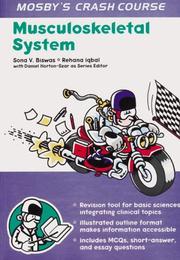
ISBN: 0723431272 9780723431275 Year: 1998 Publisher: London: Mosby,
Abstract | Keywords | Export | Availability | Bookmark
 Loading...
Loading...Choose an application
- Reference Manager
- EndNote
- RefWorks (Direct export to RefWorks)

ISBN: 2225835624 9782225835629 Year: 1998 Publisher: Paris: Masson,
Abstract | Keywords | Export | Availability | Bookmark
 Loading...
Loading...Choose an application
- Reference Manager
- EndNote
- RefWorks (Direct export to RefWorks)
Aptitudes et limites de l'enfant sain face à la pratique sportive : choix du sport, éducation physique scolaire, sport de masse et activité sportive de haut niveau. Étude des affections de l'appareil locomoteur : traumatologie, pathologies induites, compatibilités. Capacités de l'enfant malade (épilepsie, affections du système cardiopulmonaire, diabète, asthme, maladies rénales...). Caractéristiques du développement physique et des pathologies rencontrées ainsi que les points à surveiller pour un grand nombre de pratiques sportives.
Enfants --- Sports pour enfants. --- Développement. --- Athletic Injuries --- Sports --- Musculoskeletal System --- Child --- injuries --- Développement. --- Musculoskeletal System - injuries
Book
ISBN: 2225828512 9782225828515 Year: 1998 Publisher: Paris: Masson,
Abstract | Keywords | Export | Availability | Bookmark
 Loading...
Loading...Choose an application
- Reference Manager
- EndNote
- RefWorks (Direct export to RefWorks)
Traumatisme dû aux sports --- Radiologie. --- Athletic Injuries --- Diagnostic Imaging --- Musculoskeletal System --- diagnosis --- radiography --- injuries --- Traumatisme dû aux sports --- Athletic Injuries - diagnosis --- Athletic Injuries - radiography --- Musculoskeletal System - injuries
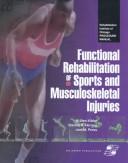
ISBN: 0834206129 Year: 1998 Publisher: Gaithersburg Aspen
Abstract | Keywords | Export | Availability | Bookmark
 Loading...
Loading...Choose an application
- Reference Manager
- EndNote
- RefWorks (Direct export to RefWorks)
Musculoskeletal system --- Sports injuries --- Sports physical therapy --- Wounds and injuries --- Patients --- Rehabilitation
Periodical
Year: 1998 Publisher: Bethesda, MD : National Institute of Arthritis and Musculoskeletal and Skin Diseases,
Abstract | Keywords | Export | Availability | Bookmark
 Loading...
Loading...Choose an application
- Reference Manager
- EndNote
- RefWorks (Direct export to RefWorks)
"An electronic newsletter designed to keep you informed about the research advances, funding opportunities, people, and events at the core of the NIAMS mission."
Arthritis --- Musculoskeletal system --- Skin --- Research --- Diseases --- National Institute of Arthritis and Musculoskeletal and Skin Diseases (U.S.)
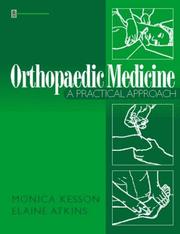
ISBN: 0750625430 Year: 1998 Publisher: Oxford ; Boston : Butterworth-Heinemann,
Abstract | Keywords | Export | Availability | Bookmark
 Loading...
Loading...Choose an application
- Reference Manager
- EndNote
- RefWorks (Direct export to RefWorks)
Musculoskeletal system --- Orthopedics. --- Anatomy, Surgical and topographic. --- Appareil locomoteur --- Orthopédie --- Wounds and injuries --- Physical therapy. --- Lésions et blessures --- Physiothérapie
Book
ISBN: 0323544983 9780323544986 0323544991 9780323824156 0323824153 Year: 1998 Publisher: St. Louis, Missouri : Mosby,
Abstract | Keywords | Export | Availability | Bookmark
 Loading...
Loading...Choose an application
- Reference Manager
- EndNote
- RefWorks (Direct export to RefWorks)
"Master the essentials of anatomy and body movement to succeed as a physical therapist assistant! Essentials of Kinesiology for the Physical Therapist Assistant, 4th Edition provides you with a solid background in the structure and function of the musculoskeletal system, with clear explanations of normal movement setting the stage for discussions of abnormal movement patterns and treatment techniques. To clarify kinesiology concepts, full-color illustrations show bones, joints, supporting ligaments, and muscles. Written by experienced physical therapy practitioners Paul Jackson Mansfield and Donald A. Neumann, this concise guide prepares PTAs for success in both the classroom and the clinical setting. And it includes a fully searchable eBook version with each print purchase!" -- Publisher's website.
Kinesiology. --- Musculoskeletal system --- Physical therapy assistants. --- Kinesiology, Applied --- Movement --- Physical Therapy Modalities --- Physical Therapist Assistants --- Physiology. --- methods --- physiology --- Physical therapist assistants --- Allied health personnel --- Cinesiology --- Human mechanics --- Motor ability --- Kinesiology --- Physical therapy assistants --- Physical therapy.
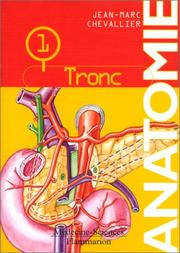
ISBN: 2257101294 2257101286 2257101308 2257101316 9782257101303 9782257101297 9782257101280 9782257101310 Year: 1998 Volume: 4 Publisher: Paris: Flammarion Médecine-Sciences,
Abstract | Keywords | Export | Availability | Bookmark
 Loading...
Loading...Choose an application
- Reference Manager
- EndNote
- RefWorks (Direct export to RefWorks)
Tronc --- Abdomen --- Thorax --- Anatomy, Regional --- Head --- Neck --- Larynx --- Pharynx --- Ear --- anatomy and histology --- Pelvis --- Anatomy --- Musculoskeletal System --- Nervous System --- Central Nervous System --- Head - anatomy and histology --- Neck - anatomy and histology --- Larynx - anatomy and histology --- Pharynx - anatomy and histology --- Ear - anatomy and histology --- Abdomen - anatomy and histology --- Thorax - anatomy and histology --- Pelvis - anatomy and histology --- Musculoskeletal System - anatomy and histology --- Nervous System - anatomy and histology --- Central Nervous System - anatomy and histology
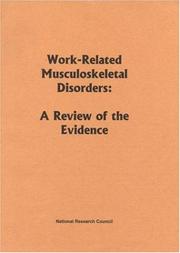
ISBN: 0309063272 9786610186143 1280186143 030959264X 0585028699 9780585028699 6610186146 9780309063272 9780309063272 0309173604 Year: 1998 Publisher: Washington, DC : National Academy Press,
Abstract | Keywords | Export | Availability | Bookmark
 Loading...
Loading...Choose an application
- Reference Manager
- EndNote
- RefWorks (Direct export to RefWorks)
MEDICAL --- Physiology --- Musculoskeletal system --- Industrial accidents --- Disability evaluation --- Musculoskeletal System --- Occupational Diseases --- Stress, Mechanical --- Musculoskeletal Diseases --- Diseases --- Anatomy --- Mechanical Processes --- Physical Processes --- Mechanical Phenomena --- Physical Phenomena --- Phenomena and Processes --- Surgery - General and By Type --- Surgery & Anesthesiology --- Health & Biological Sciences --- Wounds and injuries --- Industrial accidents. --- Disability evaluation. --- Wounds and injuries. --- Disability rating --- Estimation of disability --- Estimation of incapacity --- Incapacity, Estimation of --- Accidents, Industrial --- Accidents, Occupational --- Employees --- Industrial disasters --- Industrial injuries --- Occupational accidents --- Occupational injuries --- Musculoskeletal traumatology --- Orthopedic trauma --- Accidents --- Diagnosis --- Evaluation --- Disasters --- Musculoskeletal emergencies --- Diseases.
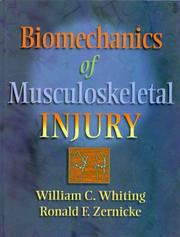
ISBN: 0873227794 Year: 1998 Publisher: Champaign, Ill. Human Kinetics
Abstract | Keywords | Export | Availability | Bookmark
 Loading...
Loading...Choose an application
- Reference Manager
- EndNote
- RefWorks (Direct export to RefWorks)
In the first book of its kind, noted biomechanists William Whiting and Ronald Zernicke explore the mechanical bases of musculoskeletal injury to better understand causal mechanisms, the effect of injury on musculoskeletal tissues, and how our current knowledge of biomechanics can contribute to injury prevention. Never before has the broad spectrum of injury mechanics been covered so completely in a single book. From introductory biomechanics to detailed examinations of the mechanical aspects of common injuries, Biomechanics of Musculoskeletal Injury provides a solid foundation for in-depth study. The book includes comprehensive information on -the basic biomechanical concepts of force, stress and strain, stiffness, and elasticity; -the mechanics of joints that are subject to disabling injury; -the structure of connective tissues (bone, cartilage, tendons, and ligaments), which are most often involved in musculoskeletal injuries; and -factors such as age, gender, nutrition, and exercise, which affect the musculoskeletal system's response to force. After providing the reader with a fundamental understanding of tissue structure and function, the authors then proceed with detailed explorations of the mechanisms of common injuries, including -inversion ankle sprains, stress fractures, and other lower-extremity injuries; -rotator cuff tears, carpal tunnel syndrome, and other injuries to the upper extremities; and -concussions, intervertebral disc injuries, and other injuries that afflict the head, neck, and trunk. Packed with more than 300 drawings, photos, and tables, Biomechanics of Musculoskeletal Injury is both visually compelling and indispensable as a reference on injury mechanisms.
General biophysics --- Physiotherapy. Alternative treatments --- kinesitherapie --- Orthopaedics. Traumatology. Plastic surgery --- Musculoskeletal system --- Wounds and injuries --- Mechanical properties --- biomechanica --- blessures --- Traumatologie --- Bewegingsorganen --- Biomechanica --- Wondzorg --- Kinesiologie --- Embryologie --- Huid --- Fysiotherapie --- Mechanical properties. --- Wounds and injuries. --- Musculoskeletal traumatology --- Orthopedic trauma --- Musculoskeletal emergencies --- Locomotor system --- Musculo-skeletal system --- Skeletomuscular system
| Listing 1 - 10 of 17 | << page >> |
Sort by
|

 Search
Search Feedback
Feedback About UniCat
About UniCat  Help
Help News
News